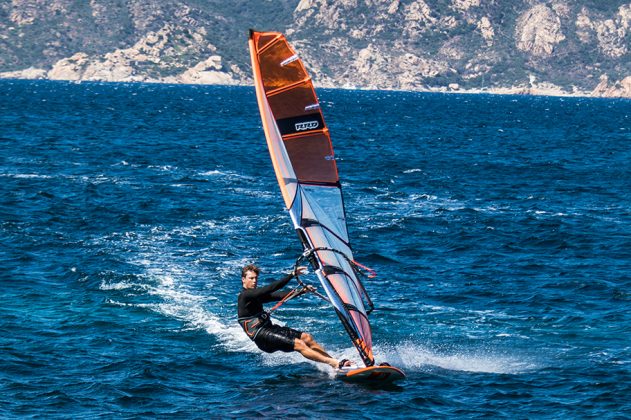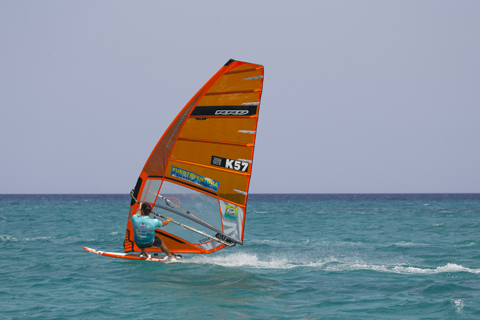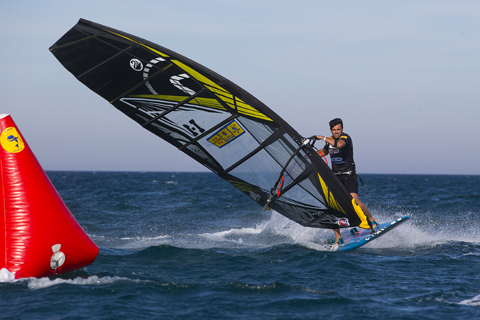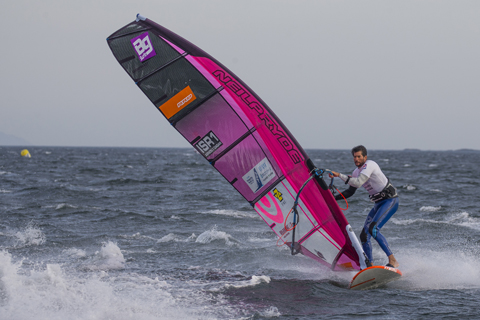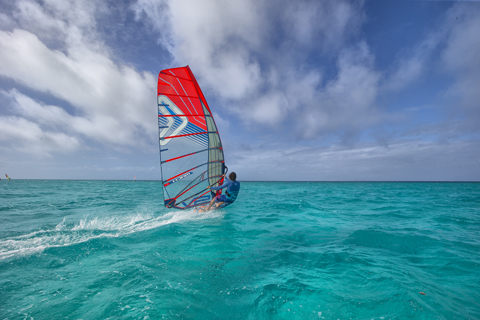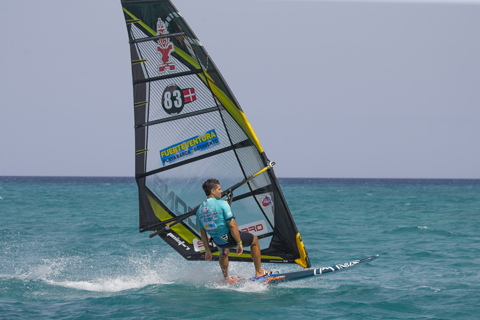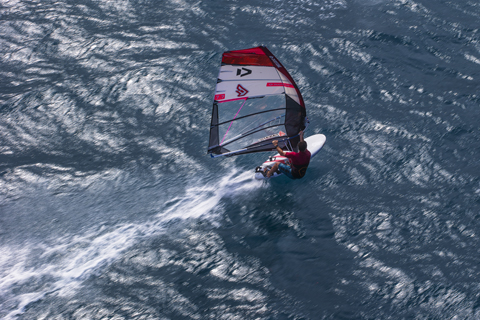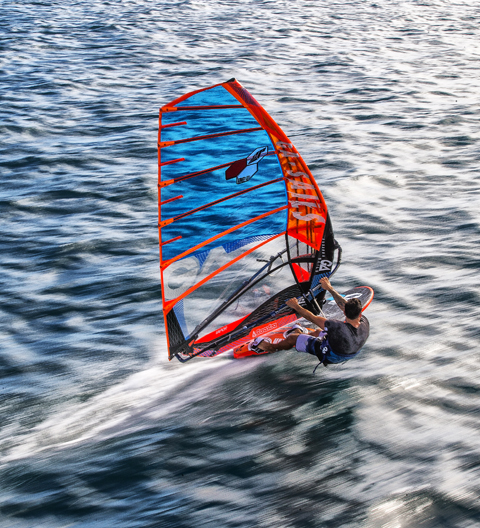Slalom racers are obsessive about every part of their equipment setup, so when it comes to masts, what are the secrets of the pros? We lift the lid on the mysterious world of slalom masts as the pros reveal what lengths do they go to in finding, testing and preserving their very best ones!
Words Ross Williams, Arnon Dagan, Kurosh Kiani, John Skye, Marco Lang, Matteo Iachino & Andrea Cucchi. // Photos John Carter
This feature originally appeared in the November/December 2018 issue of Windsurf Magazine.
JOHN SKYE
I think the main secret is testing, testing and more testing. I think most racers will have around 4 or 5 masts all the same size, the top guys maybe a lot more. They then test them all and find the best number 1 mast, which becomes a contest mast and they leave only for competition. Then number 2 probably becomes a reserve contest mast, whilst number 3 maybe becomes their training mast, and the others get sold on. The mast is really critical, so many guys will have specific masts for different conditions, if it is flat or choppy for example. Finian Maynard told me that when he finds a good mast, he keeps it forever… I imagine his garage is pretty full! For the average guy, even national racer, if you have the recommended mast inside the sail it will be fine. You will easily be getting 99.9% of the performance from the sail. When you get to World Cup level however, everyone is so fast that you need to look for every 0.1 kt improvement. Then the differences between two supposedly equal masts is important and finding a good one can make all the difference. As I said at World Cup level every 0.1 kt is super critical. I think most people approach their gear and testing in this way. If they can find 5 things that can add 0.1 kt to their speed, suddenly they are going 0.5 kts quicker, which is substantial. With boards and sails all stock production off the shelf gear, the main areas that riders can tune are masts and fins.
There are always tolerances in the masts, just like everything. Our tolerances on the masts at RRD is around 0.5%, which is tiny, but that means that you have the possibility to have 1% difference between two masts. Plus if you consider that there can be a tolerance in the top, and the bottom and the IMCS, it means the masts can feel quite different. As I said for the average consumer these tolerances are probably not noticeable, but at World Cup level it can add up to that all important 0.1 kt.
I have a mast measuring system, so when I get a new mast I always record its bend curve and stiffness. Like this I can analyse the performance better and also use different masts to test different concepts. For the ultimate race mast however I think the only true test is on the water. I have masts which measure exactly the same, but then on the water one can be slightly better than the other still. Again we are talking tiny differences, but they are there. In general on smaller sails a slightly hard top bias works well for control, whilst on the larger sizes and in lighter winds, a flex top bias can be good. However it also depends on the sail and board combo and a million other things. I generally prefer soft masts, probably because I am on the light side of racer weight. When I travel I always like to pack all the masts together tightly and ideally with sails all around them for protection. The best tip I heard is from Steve Allen who rolls the masts up inside the sails. Like that they are protected when travelling and also he has everything ready to go with the right mast rolled up in the right sail.
The main secret is testing, testing and more testing.
ANDREA CUCCHI
At Point 7 we know exactly what we like to have as curves. The curve is the difference between the top and the base of the mast. For each mast length we have a different curve to satisfy the demands of a certain condition. The same curve that works in big sails which are used in light wind and flat water, can’t be the same curve used in small sails, heavy chop and strong wind. So over the years for our team we have developed a set of masts with curves which fit each sail properly for the conditions they will be used in. From there we develop our sails, just like a tailor makes a suit for a certain body. And it’s not only for race sails, we do it for all the sails in our range. What the team uses comes directly from our warehouse 95% of the time without even checking. Each rider than has their own habits\secrets on how much care they take with their racing mast. Some use their best mast only when racing and they are treated better than their girlfriends!
The mast is the backbone of the sail. Our sail has a stronger character over the mast, so it’s less important perhaps than some other brands. But if you have a mast which is the best compromise between power and control, than you have a winning mast for your sails. It’s about finding the right percentage difference between the base and the top, and having a comfortable IMCS according to the needs of the sailor. A heavier sailor likes stiffer masts, and light sailor softer masts. Generally though if the combination between mast and sail is good, both sailors enjoy the same masts. A good mast can give you so much extra comfort, that allows you to focus on other things, rather than constantly tweaking the sail or your stance. It translates into a lot more speed and less energy used over a day. We are talking about knots of difference.
If we talk about bad masts or good masts because the curves are different, in numbers it can translate into having a very small difference. Let’s take a percentage number of a standard mast base at 63%. If it would be 62.7% or 63.3%, good pros would see the difference on the water. This small difference could result in those same pros calling it a ‘bad’ mast. Of course if we than talk quality of construction and materials, than this can also create a big gap between a good and bad mast. In both cases a good mast or bad mast will make enough difference to either be first or last in the same PWA slalom heat. On a bad mast the acceleration is worse, the control is worse, the push on the sail is different and tensions aren’t right. In a straight line the energy and effort required to make your gear go fast is much more on a bad mast. And it does not matter how much energy you put in, it will always give a bad result. Plus after having to fight so much in a straight line with a bad mast, your focus on gybing and racing is lost.
Masts are all black and look the same. There are stickers which can say one thing, but who knows the truth! The first priority is to be sure that the manufacturer which produced the masts has a meticulous quality check system, to insure the resin and carbon are assembled in a very systematic way and that the materials used are always the same. Skilled labour, measurements and material are fundamental. Even working with the best supplier there can be small differences. We measure all the masts which leave the factory. If the difference is not going to make our sail feel as it should, the mast is discarded. We cannot afford to have our riders or clients not fully appreciate the advantages that our rig can have. We produce our masts in Italy, next to where we are testing, so for us it’s very easy to make sure our product is well certified and controlled.
On land we have all the numbers of the curves of the masts, and from there we know what to change on the mast curve to obtain what we believe will give the advantage. If a small difference is felt on the water, than we have prototypes produced with the different numbers of curve percentages, but otherwise similar, and we find the best mast by going windsurfing. On the water, the best practice is to have one tester keep all his gear the same, and the other tester to rotate through the masts which need to be tested. Once the testers are on the water there are various factors to be tested. How easy the mast pumps out of the jibe; the power in acceleration from low speed to top speed; the comfort and average speed. Once the best mast is found, the testers than do further crosschecks to ensure it really is the best one.
What our top racers have in the smaller mast sizes, like 430 and 400, is a softer version of the mast. The curves stay the same, as it’s a very fixed point we have, but the IMCS can be a little softer. This is to give them a chance to use these softer version in extremely ‘wavy’ and choppy / windy conditions that a recreational windsurfer would not use that kind of equipment (slalom sails) in. These masts are often used in Fuerteventura. It’s more about control than speed in that case. For our normal range, whatever is best goes in production, we don’t keep secrets or special things for the team.
As a rider, it’s a disaster when you keep your very best mast too long and suddenly it breaks. In the last few years I haven’t had to swim in with a broken mast so I’m happy! As the CEO of Point-7, I don’t want to think about a disaster with masts, and this is why we make even our 30% carbon content mast in Italy. The manufacturer is next to us, we can check out our product anytime. We cannot think that 1 mast breaking out of 100 is good. It’s one person swimming and we know that’s not fun. Masts are not eternal, and we need to remember this also. The performance dies out over time as anything does with wear. So keeping your mast up to date is never a bad choice!
Normally you would use your best masts for racing only. Don’t leave them rigged, or if you do, make sure there is ZERO tension on them. If they are not in the sun it’s better. Make sure that inside the mast is always clean, not just the outside. Try not to hit it, drop it, and never lend it. There is a reason why they are given with padded bags. How do I care for my best mast? I give it to the best rider in my team, see if he likes it better than his best one and if he does, he keeps it. Otherwise I use it every day as I want to be the fastest, even for fun freeride blasting. There are too many good days of wind to enjoy the best mast only a few days a year!
The mast is the backbone of the sail.
ARNON DAGAN
There are many mast secrets and they include the endless search for a perfect curve, flex and weight of mast. Pros mix and match tops and bottoms, try crazy different curves, diameters, materials and measure masts to be able to duplicate and understand what is best for their sails. I like to think of the mast as the spine of a human. It is what holds the structure of the sail together and helps define the sail’s shape, stiffness and flex. Therefore a well suited mast can improve the performance tremendously and not only on a race sail, but on any type of sail -wave, freeride, any type, even for beginners. The bigger the mast length the stiffer it has to be to be able to hold the structure of the taller sail. Producing a mast is a very complicated procedure, therefore you can often find differences between masts, even from the same brands. These days the differences are a bit smaller as mast companies are getting better. You can find big differences between brands due to different materials, bend curves and stiffness. I test my masts systematically with another pro sailor. You sail together and test speed against each other. One sailor stays the same while one changes the mast and can feel and see the difference in speed, power, stiffness and more. Furthermore I measure my masts and I rig and feel the sail on the beach using my experience to know what look and feel I’m searching for.
You have three main types of masts:
Hard top – the top of the mast will be hard and bend less.
Constant curve – the masts will have a consistent curve all the way.
Flex top – the top of the mast will be softer and bend more.
You use the various kinds when you wish to achieve a certain handling characteristic on your sail. You can fix problems with your sail’s tuning by changing the curve. Most brands like to use constant curve or flex top masts. For a hard top mast, since the top is stiffer it will make the bottom softer then normal. This normally makes the profile of the sail flatter and opens the middle of the leech, which can result in instability, as while sailing the sail it can break in the middle and become soft and bendy. If you have a super full shaped sail with a tight leech you can use this sort of mast.
A constant curve mast is the most popular. This will also open the mid leech and give freedom and release to the sail. It will make the sail a touch flatter but less so than a hard top mast and the sail will pump nicely. This type of mast is the compromise between flex top and hard top masts and is used by most companies.
A top flex mast has power, stability and less release. The sail will open only in the top and will normally have a very full and stable profile. However it will release the wind in a different way then other types of masts and creates a lot of power on your harness and hands. Neil Pryde use a constant curve mast with a touch of top flex sometimes. However we keep an open mind to different curves to fit other kinds of sails. I have had masts break in the middle of a race, break out to sea in massive waves or break and then completely destroy the sail. I have probably broke way over 100 masts so far! A good mast to a racer is like gold, you don’t throw it on the ground, you keep it out of the sun and you protect it with extra plastic covers while travelling!
A good mast to a racer is like gold.
MATTEO IACHINO
The majority of racers use the normal production masts most of the time. The main difference is that our masts are checked one by one to see if the curve is exactly the one we want on that sail. We have many masts with the same length and we test them to find out which one fits better on that specific sail size. The mast basically is what makes the sail alive. It can give you more control, more speed and more acceleration. A high performance sail without the correct mast cannot go anywhere. The difference can be pretty big. Many times it’s not about how good a mast is, but it’s more about what the mast does to the sail. If we race on a flat water spot we can use a stiffer mast that gives more depth to the sail and a super stable feeling. On the other hand if you sail on rough water you might want a soft feeling, light over the board and easier to control. There is not normally a huge difference between two masts from the same brand, but there could be enough difference for a pro rider to appreciate one more than another in certain conditions. It’s impossible to produce the exact same mast time after time and that’s why we spend so much time searching for the perfect one.
To test I do runs with a rider I trust and also using my GPS. Then your sparring partner doesn’t change or move anything while you change mast trying to give the sail the same downhaul and adjustments and then you go testing again. I write down the numbers of the good ones in certain conditions to remember better, otherwise it can get confusing after a while. I prefer a stiff mast with a deeper sail profile in flat water / light winds, while I choose a soft one for rougher conditions. A soft mast moves more and lets the sail ‘breathe’ more, so you can actually avoid moving your body while hitting the chop/waves. In the end it’s similar to adjusting a car’s suspension depending on what terrain you are going to drive on. You can lose a race or an entire event because of snapping one mast. It happened to me last season and it has happened to every rider at least once. It takes a while to find the one you like the best and once you find it, you try to protect it from anything that could create damage. I try to avoid any sun or heat exposure and they are super protected when I am travelling on planes for the World Cup. I do my best to cover the sail as soon as I’m on the beach in warm places. As soon as the race is called off, I take out the cambers and release the downhaul. I prefer to ruin the sail a little bit rather than keeping the mast flexed for a long time.
The mast basically is what makes the sail alive.
KUROSH KIANI
In reality, masts from manufacturers are supposed to be the same, but tiny differences here and there can end up making quite a difference in the end. The measurement of mast curves is (in my opinion) relatively primitive, so there is room for lots of unanswered questions. The secret for me has been to try as many rigs as possible, even from different brands, to see what is going on, and how other rigs feel. Furthermore to ascertain any conclusive results, you have to be structured, technical and take notes on stuff you´ve tried over the years. If you do it long enough, a pattern generally starts to emerge and you start to understand your and your rig’s needs for a mast.
The difference between a good and a bad mast, such as in a mast that suits your sail and one that doesn´t can be huge! With just the right mast, your rig comes to life. You start to feel how the top has just the right bounce when you hit the chop, and the same with the bottom. It accelerates you and is easy to pump. The right mast can make the difference between finishing first or last. A mast that suits your sail will be fast, easy to pump and won’t wear you down. In theory there should be no differences between production masts, but this process is simply so hard to control that you inevitably end up having tiny differences in the mast while the mast still stays within the specifications it was designed for. And at the top level, even a tiny difference is enough to be significant! After a while, you more or less know once you´ve rigged the sail, pumped it a bit on the beach and assessed how it looks if you have the correct mast for a certain sail. But of course, you´ve got to test it out on the water, ideally with a testing partner who is close to your speed. But nowadays I can also use GPS. I have enough historical data which I bind to the general feeling of the rig, and work my way up from there.
These days we usually divide the masts up into three categories – “Constant Curve”, “Flex Top” and “Hard Top”. Apart from that we use the so called IMCS number to describe the curve of the mast. The higher the IMCS, the stiffer the mast. The IMCS is calculated from the relative top/middle/bottom deflection of the mast from its idle position with 30 kg of weight on its centre.
For my sails (Point-7) we are typically looking for one specific mast which fits the sail in terms of top/middle/bottom deflection. Having said that, some guys usually like the softer masts while others like them stiffer. I personally try to get the perfect mast for the luff curve of the sail. If it really fits, you will know when you hit the water!
I will go as far as it takes to get that perfect mast! The mast is an integral part of your whole system, and a part I can’t relax about. I have to keep pushing further and further to find the next best mast! Once I´ve found them, they will be in a different bag by themselves, only to be taken out on rare occasions. I keep my masts stored in a nice environment and make sure they are in a place where they can’t get damaged. And I limit the use of them as much as I can.
I will go as far as it takes to get that perfect mast!
MARCO LANG
I don´t know about the other brands, but the Duotone team are only using production masts, the same masts that each customer can buy in a shop. For sure we are testing and trying to develop some proto masts to improve our products, but in racing we are all using production masts. For me it’s important to give customers the same feeling that we have, to sail the same material that we use on the PWA World Tour. Our only advantage is that we have the opportunity to test around 5 masts of each size and we choose the best ones for racing.
I always try to explain that the correct mast is the most important thing to get the best performance from your sail. I would say it is of equivalent importance as a good tire on a car, you cannot put a Fiat tire on a Ferrari! The right mast can make all the difference. For example, with a soft bottom you get a lot of back hand pressure and with a stiff bottom the sail becomes more stable and you will get a better acceleration. It is our (Duotone) goal to reduce the differences and offer the customers a good average mast. Professional riders definitely feel a difference between different masts. Same as they feel a difference between different boards, sails and fins. If it comes to winning races even the tiniest difference can impact on winning or not winning. A regular customer though will have to have a very advanced level to feel a big difference. At Duotone we’ve reduced the difference between the masts, but we still offer customers a choice of carbon content. It´s important that customers always choose the right mast for the right sail. We always give a recommendation for each sail design, so the customer gets an idea which mast works best.
I prefer to test masts on flat water, so each rider has the same conditions for testing and so we can achieve an accurate test result. Sometimes we are testing 15 masts per day. So it’s important that we write feedback down immediately before we lose the feeling and forget about the details. Sailor 1 keeps the same sail with the same settings and a good reference mast and sailor 2 changes masts and then hopefully we are able to see some differences. The most important characteristics for me are stability, acceleration and power! I am always using the same mast in all kinds of conditions to have the same performance. The way I care for my best masts is top secret. I leave all my good masts at home, I do not bring them to Tenerife for winter training. My best masts are safe in my storage unit in Austria. I never sign them with best or number 1. At the beginning of the season when I receive all my masts I sign them from 1-10 and try them. So my best mast is a random number just to be sure nobody steals or borrows my best ones.
The correct mast is the most important thing to get the best performance from your sail.
ROSS WILLIAMS
I think everyone knows a good mast can really make a difference, it is not a big secret. Being the fastest and most consistent is about spending time on your equipment and figuring out what your needs are for every type of condition and racecourse; there are no short cuts. A really good mast can be a game changer in your race sail. A nice mast is going to be more reactive and have better top speed and control. If you are able to achieve all of those gains from changing one mast it could translate to a 10% or more improvement in speed and who wouldn’t want that. Personally I haven’t really found our brand make any really bad masts since we changed our bend curve, maybe the factory has improved its ability to preciously reproduce their products now. It does not stop you searching around to find a magical one in the quiver. I wouldn’t want to think that I am sailing on a bad mast. It really would be terrible! That would be like sailing with a fin cover still over you fin!
Mast variations depend on the manufacturer. Italic, who make our masts, seem to have got it figured out. For sure there are differences, but you can be splitting hairs. As racers we endeavour to strive for that fine tuning that can make the difference and in regard to masts it’s about finding the mast you prefer and suits your style of sailing. So it’s always best to check every mast and find your preference. I use GPS, and test the speeds on various angles off the wind and then log the results. I also try to sail with a buddy to cross reference it. And then I go on feel, how the mast feels in my hands when on the water. Depending on the racing conditions I might have a certain need for control versus top speed, so there has to be a trade off!
In slalom I always just order my masts each season, test them and then in the end keep the best ones and hold onto them until I am sure that I have found at least two more that are preforming better. When we were racing formula I did find I had a couple of old masts that always seemed to be way better than the new masts that were being produced. I would treat those specially and only bring them out for the super important World and European championships. I haven’t yet had any disasters with losing masts and breaking them during a really important race. Maybe I am doing something right! I give my masts names and sleep with them in my bed. Seems to work. No actually I try to keep them safe from extreme heat, especially when they are under tension. If I have to travel on a plane with them I might try and make sure the best masts are really tucked away somewhere safe in the middle of the pack so they have other masts or equipment protecting them. That is it, no big secrets, just time and care!
A really good mast can be a game changer in your race sail.


